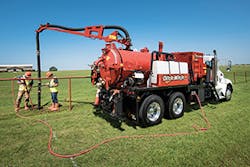For Jason Proctor, product manager for vacuum excavation for Ditch Witch, contractors who invest in vacuum excavators are buying a sort of insurance policy, one that could even save their businesses. His point is well taken. Vacuum excavators increase the odds that construction crews won’t accidently cut into gas, water, or electrical lines while digging. And, this type of protection is invaluable: Operators and workers who do accidentally hit utilities when digging? They can cause contractors heavy fines, terrible publicity, and lost future jobs.
That’s why Proctor, along with other manufacturers, recommend that those contractors who frequently dig near utilities make the upfront investment in a vacuum excavator. “I always use the analogy that a vacuum excavator is like an insurance policy,” says Proctor. “It’s a way to expose the utility in some manner, and visually verify its location and depth. It’s the only sure way to know what utilities are in the ground, and how to avoid them. That’s why it’s like insurance: You can visually verify the utility so that you reduce the chances of suffering liability and damage. It all comes back to preventing damage.”
Contractors have long turned to vacuum excavators to protect themselves and their workers when digging. Plus, Proctor and other manufacturers say that these contractors are continuing to embrace vacuum excavation largely because of these safety issues.
Vacuum excavators rely on high-pressure water or air to expose buried cables.
The most basic difference between air and water is one is a gas and is compressible and the other is a liquid and is non-compressible. In many situations, this makes air safer to use in vacuum excavation than water. When air hits something solid such as a buried utility, it will compress and flow around it.
Air systems work by using the energy stored in compressed air to explode apart the soil, while water works by cutting the soil and turning it into mud. The advantages with air are that in most soils excavation is quicker, spoils stay dry and can be used for backfill and water creates mud which can be difficult to deal with.
Trevor Connelly, the vice-president of Vacmasters—which makes both types of systems says—”One of the major problems with water is that it is very indiscriminate in what it cuts, either the soil, or the utility buried within the soil.”
Vacmasters makes air vacuum excavators that come in the same sizes as hydro vacuum excavators. According to Connelly, “As more awareness has come to light on the huge advantages of using high pressure air to complete contractors vacuum excavation projects, many contracts have come to specify what type of vacuum excavation needs to be used: air-vacuum excavation.”
Lessening the Risk
Using an air or water system, operators can accurately assess the exact depth and size of a utility, significantly decreasing the chances that construction crews will damage that utility–or injure themselves by cutting into a live electrical or gas line–when digging.
Manufacturer Super Products is a longtime provider of these excavators. The company says that vacuum excavators provide an important safety boost on job sites, based on how these machines work. Vacuum excavators rely on pressurized water and industrial-strength vacuum suction to quickly and efficiently excavate and evacuate soil. The soil and water slurry created through this excavation process is then sent by vacuum power to a debris tank, according to Super Products.
Super Products says that because this method of excavation uses water or air to break up the soil instead of sharp tools, it eliminates most of the risk of damaging underground utilities. This method of excavation also requires less backfill, labor hours, and restoration work. This means that contractors not only complete jobs with less risk of accident or injury, they are also more likely to complete them faster and turn them around on budget.
“The real growth in this industry in the last 10 years has been spurred by past accidents,” says Proctor. “There have been explosions, some loss of life, loss of property, all because someone cut into a utility line. Those accidents have put a focus on the industry as a whole coming together to make sure that we identify ways to reduce that damage.”
The increased investment in vacuum excavators is a long-term trend, Proctor says. Contractors will continue to rely on this equipment to reduce their risk during excavation work. Every time a newspaper or website reports on a home destroyed or flooded because construction crews cut into a utility line, the demand for excavators will only continue to grow.
“If an accident happens around an explosive material, there could be catastrophic consequences,” says Proctor. “If we are talking water or telecommunications, it is the inconvenience that contractors cause those customers. That liability often falls back on the contractors. If there is a more serious accident that causes property damage or injuries, that can be terribly catastrophic for contractors.”
Technology Boost
The good news for contractors is that manufacturers are constantly improving the technology associated with vacuum and hydro excavators. The machines have become easier to use, lighter, and more efficient, all of which can make a significant difference to the bottom lines of the contractors who rely on them. Ben Schmitt, product manager for Vactor Manufacturing, says technology advancements in vacuum excavation during the last decade have focused mainly on three areas: the productivity of excavators, reducing the sound levels of excavation equipment, and lowering the operating weight of truck vacs.
This has been a positive for the makers of excavators, Schmitt says. “The improved productivity inherent with vacuum excavation, combined with the oil and gas industry’s focus on protecting underground infrastructure and alternate uses for the technology, have helped drive significant demand for vacuum excavation.”
Productivity improvements, of course, have been key. Contractors want to work as quickly and efficiently as possible to maximize their bottom lines. They have a better chance of doing this if the excavators they work with operate more efficiently.
Most of the productivity improvements in the excavation field have focused on the booms of vacuum excavators, Schmitt says. The boom, of course, is the primary working end of a vacuum excavator. If this boom can reach greater distances and cover more working area, it greatly increases the productivity of excavator operators.
Sound improvements—namely, lowering the amount of noise excavators make—have played an important role, too, in making excavators a more common choice for contractors. Manufacturers today work on lowering the volume of their excavators mainly because it is more likely that contractors will use this equipment in crowded urban areas than in the past.
Contractors can face significant fines if they operate excavators that are too noisy for urban environments, Schmitt says. “With the growing prevalence of vacuum excavation in urban areas, the noise level of the equipment has also become an issue,” he says. “Unlike oil and gas applications typically conducted in remote, rural areas, urban settings have very strict noise pollution regulations.”
Proctor says that manufacturers have already made great strides in reducing the noise levels of vacuum excavators. The sound levels have been dampened so much, he adds, that business owners and homeowners near a job site are often surprised at just how little noise excavators make.
“It’s been important to reduce sound not just for the operators but for the environment they are operating in,” says Proctor. “A lot of customers are impressed when they see a large piece of equipment like this rolling into the neighborhood. They are surprised at how quiet it is. They expected much worse. It’s nice when you hear comments about how quiet the machines are, when you get that feedback.”
Then there is operating weight, which Schmitt says is a crucial issue for contractors relying on vacuum excavation equipment. Again, the fact that contractors are more frequently turning to excavators in urban areas has made weight concerns more important.
“Most oil and gas applications are being performed in very remote locations, often with gravel roads, so the overall weight of the vacuum excavation equipment is a non-issue,” says Schmitt. “But in cities and municipalities, where the primary focus is on protecting underground utilities, weight restrictions have pushed manufacturers to design vacuum excavation equipment that can legally haul material over roadways.”
Manufacturers who do make lighter excavation equipment can actually boost the productivity of their customers, Schmitt says. “The more material an operator can haul in a vacuum excavator, the longer they can stay on the job and the more productive they can be,” he adds.
Proctor says manufacturers have also focused in recent years on reducing the emissions generated by vacuum excavators. This has been especially important as state and federal agencies have enacted more stringent emission requirements. Today’s vacuum excavators, then, are generally kinder to the environment.
Manufacturers are also focusing on increasing the comfort levels of the operators of vacuum excavators. This is resulting in more ergonomic designs created to place less stress on the bodies of operators, Proctor says.
“Operating a vacuum system is one of the most labor-intensive jobs in underground construction,” he says. “It is a lot of connecting hoses, manual labor and moving hoses around. The physical nature of blasting water into the ground can take its toll. There is a substantial amount of physical labor required for this job. We continue to evolve our equipment to make it more ergonomic for those operators.”
Better Working Conditions
For Jeff Wage, vice president with McLaughlin, the biggest technology advancements concerning vacuum excavators haven’t come with the machines themselves. Instead, the bigger advancements have come in the form of increased expectations on job sites and improvements in the way contractors handle excavating work.
Wage says that contractors today in general offer more training and better safeguards to workers who are excavating. There is a greater emphasis on safety, especially when it comes to the sometimes high-risk job of excavating and creating deep trenches. Part of this is a simple concern for their workers. Contractors don’t want to see their employees injured during excavation work, so they focus more on training these workers on how to dig and operate excavators safely.
Then, there is the financial incentive. Contractors can lose both labor hours and money if their workers suffer an accident during excavation work. The job site will be shut down as the accident is investigated, something that could cost them future work from clients. Contractors who don’t follow basic safety rules might also face significant financial penalties from state or federal agencies. So, it makes financial sense for contractors to focus on safety and make their job sites less dangerous when their workers are operating excavators, Wage says.
Safety Matters
At the same time, contractors are taking more steps to make sure that their excavator operators don’t accidentally damage utility lines while digging. Again, this isn’t necessarily an example of excavator manufacturers boosting the technology of their equipment; but, it is an example of contractors improving the working conditions on a job site—something that is equally as important to contractors hoping to boost their bottom lines and not lose money because of delays or costly mistakes.
“The goal now is all about safe digging,” says Wage. “It’s about eliminating some of the liabilities and risk of damaging third-party utilities when you excavate. On the job sites, the contractors were sometimes required to use vacuum excavation, but not usually. That is something that you are seeing more and more end users requiring. It is more often becoming part of the bidding process.”
Safety has long been an important driver for the sale of vacuum excavators because digging comes with so many potential dangers. Construction crews tasked with excavating large amounts of soil might accidentally hit a utility line, inconveniencing homes and businesses that might suddenly lose power. But the consequences can be even more severe if they accidently hit a gas line. Explosions or fires can result. Those who strike a water line can immediately flood an area.
And that’s just property damage. Workers can seriously injure themselves, even fatally, if they strike the wrong utility line.
In short, soil excavation can be a dangerous job. Just consider the jobs that the operators of this equipment take on.
“Vacuum excavator operators can experience a wide range of conditions on the job,” says Schmitt. “Many contractors respond to emergencies such as a water main break, which could occur late at night or in extremely cold weather. Some contractors will work in temperatures approaching -40 degrees Fahrenheit.”
Fortunately, not only does vacuum excavation itself increase safety—contractors are far less likely to hit utility lines if they are using excavators—but also the vacuum excavators themselves are becoming safer.
Schmitt says, for instance, that many vacuum excavators today feature enclosed heating cabinets or warming boxes to keep operators warmer in freezing temperatures.
Historically, contractors have used excavators in the most sensitive of areas on a job site, turning to the machines when they were digging near a power box or a congested utility area, Wage says. That is still the case. But, contractors are now turning to excavators more often in a wider variety of locations.
He points to jobs involving open water and sewer work. More often today, owners require that contractors excavate every 15–20 feet to look for obstructions or crossing utilities.
“The way operators and contractors who own vacs operate has changed. The standard has changed,” says Wage. “Contractors used to say, ‘Spot the utility with a vac.’ That was their marching orders. It wasn’t any more specific than that. Now the contractors have specific requirements for how they need to expose utilities so that there is less risk that they will accidentally damage them.”
Wage says that safety concerns are driving the increase in business for the makers of vacuum excavators. Smart contractors know that investing in this equipment can save them both money and hassles.
“Contractors will see paint on the ground, so they know there is a utility there,” says Wage. “They’ll have a backhoe or shovel, and be digging. One wrong swipe, and an operator will hit the gas main. One spark, and you have torched the machine to the ground. That is the image that people see, someone hitting a gas line and burning their machine to the ground. Or, maybe a contractor will get gas into the sewer system and blow a home up. Having the excavators is all about not damaging other utilities; it’s about not creating health and safety risks or costly repairs.”
Wage points to an example of how not having an excavator can hurt. Recently, a utility contractor was working in front of McLaughlin’s plant in Greenville, SC. The contractor was smaller, and wasn’t using an excavator. Wage says McLaughlin offered to lend the contractor a vacuum excavator so that it could make sure that it wasn’t digging near a utility.
The contractor refused the offer. Staffers at the McLaughlin facility left the building for lunch. By the time they had returned, the contractor—operating a backhoe—hooked a water main, flooding the entire front of McLaughlin’s property. McLaughlin had to shut down its manufacturing plant until the mess was cleaned up.
It all could have been avoided if the contractor had been using an excavator, Wage says. “That really highlighted the dangers of not having a vac,” he explains. “That cost and downtime, the repair costs—it made a big difference to that contractor.”
Less PSI, More Control
Another big change? Owners no longer want contractors digging with non-rotary nozzles that are too powerful. That’s because these ultra-powerful nozzles provide operators with less control, making it more likely that they will damage a utility line.
“One of the more important changes I’ve seen is with how fast you can erode the soil,” says Wage. “Some of the vac trucks in the past would use a non-rotary nozzle. You would get contractors digging at 5,000 PSI with a non-rotary nozzle. That has changed dramatically in the last 10 years as the industry has zeroed in and settled in on what utilities would rather see when it comes to nozzles and PSI.”
Today, utility owners want contractors to use a rotary nozzle or tip with their vacuum extractors and to dig at no more than 3,000 PSI. “That might not always be as productive as digging at a more powerful PSI, but it is safer,” says Wage. “It might take you a bit longer to dig up that soil, but you are accomplishing the more important goal of safe digging. From a technology standpoint, we are seeing settings on nozzle tips to match that requirement to dig at 2,500 to 3,000 PSI, where the industry has settled.”
The municipalities and owners who hire contractors want cleaner, neater work. That, too, has provided a boost in the demand for excavators.
As Wage says, utilities often need to be spotted under sidewalks or busy roads. The practice of jack-hammering out large pieces of pavement and then covering them with big patches is falling into disfavor.
“That’s just an ugly way to do it,” he says. “Municipalities no longer want those ugly patches dotting their streets.”
Instead, contractors are being asked to cut uniform holes in roadways and sidewalks without any sharp edges. Municipalities want contractors to create a minimum of disruption of the concrete.
“You cut that core, do your vacuum excavation, and reinstate that same core back in the road,” adds Wage. “That is a cleaner look. And it’s a faster job. You can keep road congestion to a minimum.”
Meeting Weight Regulations and Avoiding Big Fines
Contractors face plenty of challenges when vacuum excavating. But one of the biggest today might have to deal with the weight of vac trucks once these trucks are filled with soil and water. As Wage says, trucks that weight too much when full run the risk of incurring fines from state departments of transportation. Contractors that try to run these trucks over roadways even when they weigh too much can hurt the bottom lines of their businesses with fines and penalties.
“That’s one of the frequent questions we get when it comes to vac trucks, ‘Does it scale?’ he says.
Wage continues, saying contractors today face more stringent federal and state regulations. They also have fewer dumping sites from which to choose. This puts pressure on them to make sure that they are never carrying too much weight on their trucks during an excavation job. In some states, the fines for exceeding weight restrictions can be as high as $10,000, according to information published by McLaughlin.
To make sure that they don’t exceed weight restrictions, McLaughlin recommends that contractors first choose a truck vac that has a gross vehicle weight rating that will make it less likely that they will exceed DOT regulations. The gross vehicle weight rating includes the mass of the truck’s chassis, body, engine, fuel, accessories, driver, passengers, and cargo. Cargo for a truck vac is often spoil.
Truck vac axles matter, too, if contractors want to avoid fines for violating federal bridge laws. These laws regulate how weight is distributed on each of a truck’s axles. Trucks with one axle can have 20,000 pounds of carrying weight, while those with two that are spaced within 96 inches apart can have 34,000 pounds of carrying weight. A third drop or pusher axle if within 96 inches of another axle can allow for 17,000 additional pounds of carrying weight.
All of these numbers are critical to contractors hoping to avoid weight fines when carrying water and soil, Wage says. “When a guy is full at the end of the day, a contractor doesn’t want to have the liability of that truck being overweight,” he says. “They don’t want to face the penalties of having an operator driving a vehicle that is overweight.”
Training Makes the Difference
Training is key for contractors who want to make sure that their construction crews operate vacuum extractors as efficiently and safely as possible. Schmitt says that contractors need to train their operators in the proper setup, operation, evacuation techniques, and load handling.
“Vacuum excavation equipment operators must be proficient in the safe and proper use of the equipment to protect vulnerable and expensive infrastructure,” he says. “While it can take some time to master, excavation technique and nozzle performance can really improve overall productivity.”
The future of the hydro and vacuum excavation industry looks solid, largely because the customer base for this equipment is growing. Schmitt says that there was a time when the main chunk of the excavator customer base was made up of oil and gas companies. That has changed, though, as the price of oil continues to fall.
Now, he says, construction contractors, municipalities, and utilities are more frequently turning to excavators. These newer customers are now driving an increase in demand for the equipment. And, the best news for manufacturers is that this segment of the customer base is showing no signs of shrinking.










